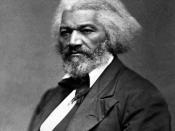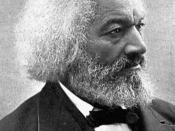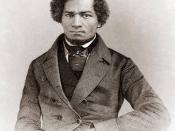The issue of slavery has been touched upon often in the course of history. Not often do we get to learn about the inner struggles of a slave spiritually and intellectually. Through Frederick Douglass and his Narrative, we can see into slavery from a physical state as well as from a mental state. Frederick Douglass' Narrative of his life is an account of his experiences both during and following his life as a slave. It focuses on a realm of spiritual development that is simultaneously countered by the lack of movement on more concrete levels, specifically those of a uniform, legal liberation as well as a mental and emotional liberation from slavery. It is in the midst of this battle for spirituality that he encounters and develops his faith and comes to terms with himself as not only as a slave, but also as a man, an African American.
Douglass' Narrative, in many ways, reflects upon the events in his life as they occurred. The physical details allow the reader to vividly see both maturation and decay of Douglass as a person and of the institution of slavery. The physical regression of Douglass and his environment and the progression of Douglass' spirituality can be perceived as diverging forces on a spectrum with each end continuously extending outward to maintain balance in the middle. For example, during his time in Baltimore, his unrelenting desire for literary knowledge was strongly influenced by his master's decision to forbid his education. Douglass eventually learned to read and write with the help of several children whom he became increasingly attached to; as he states in his own words, "I owe almost as much to the bitter opposition of my master, as to the kindly aid of my mistress." Other instances of regression producing spiritual...


